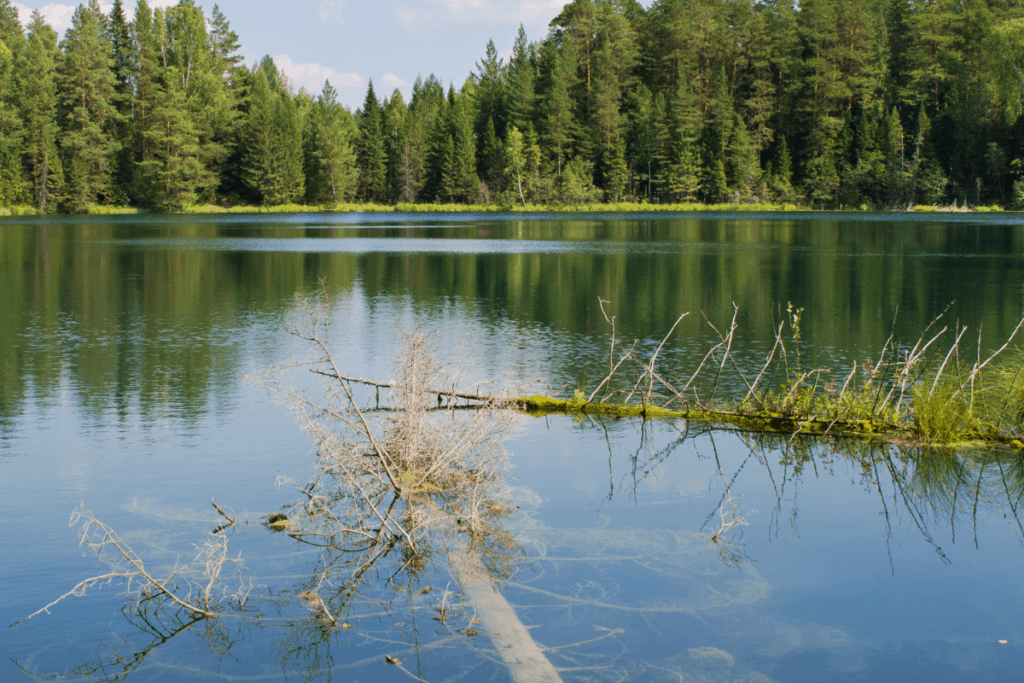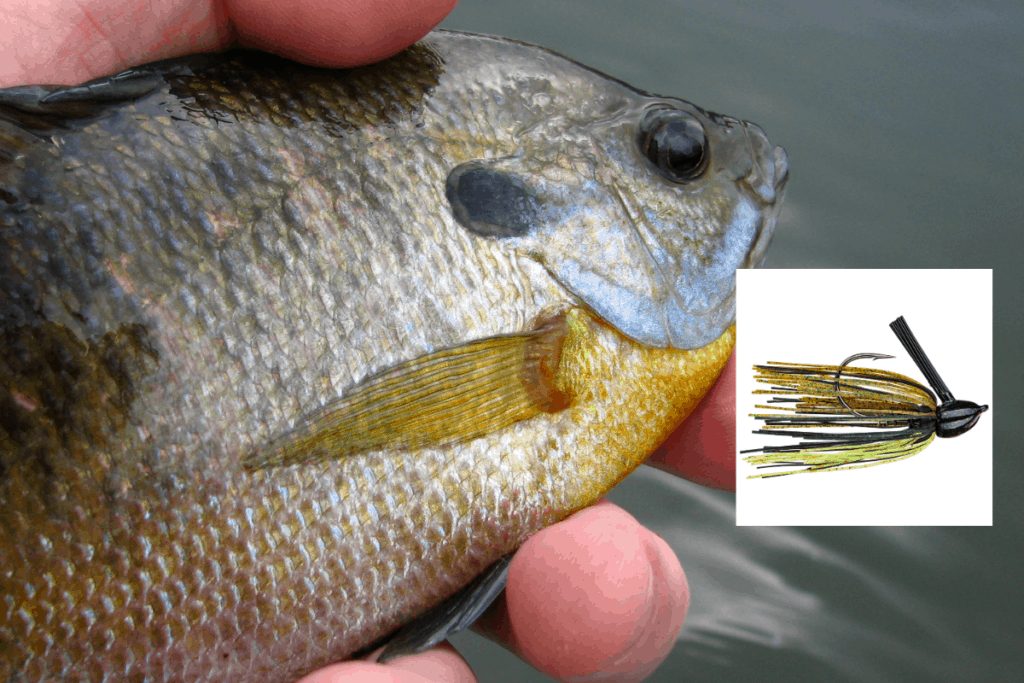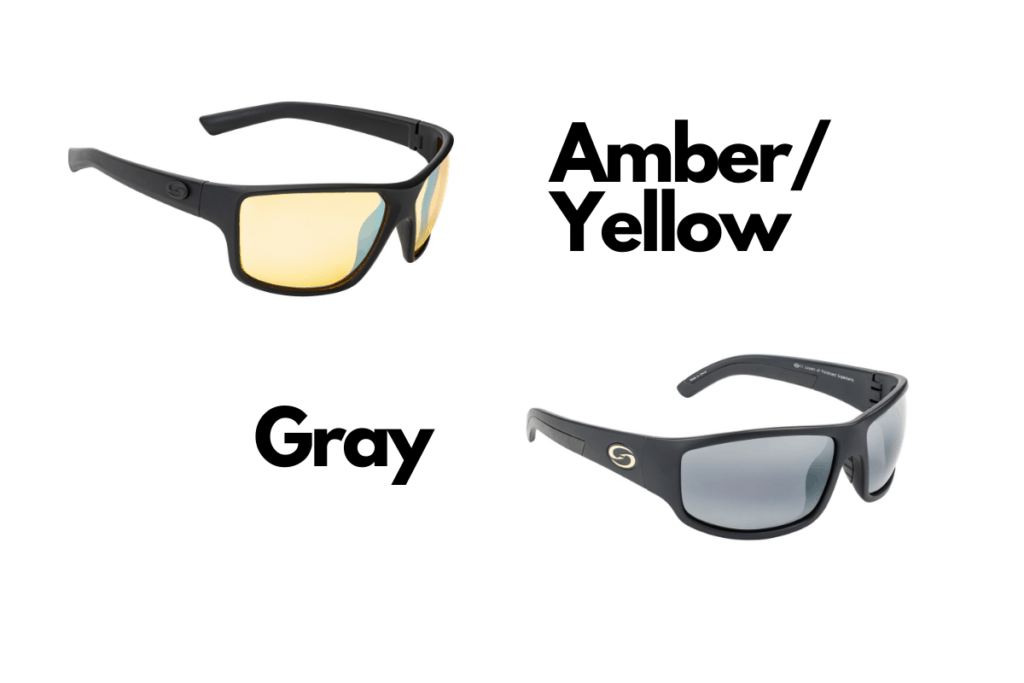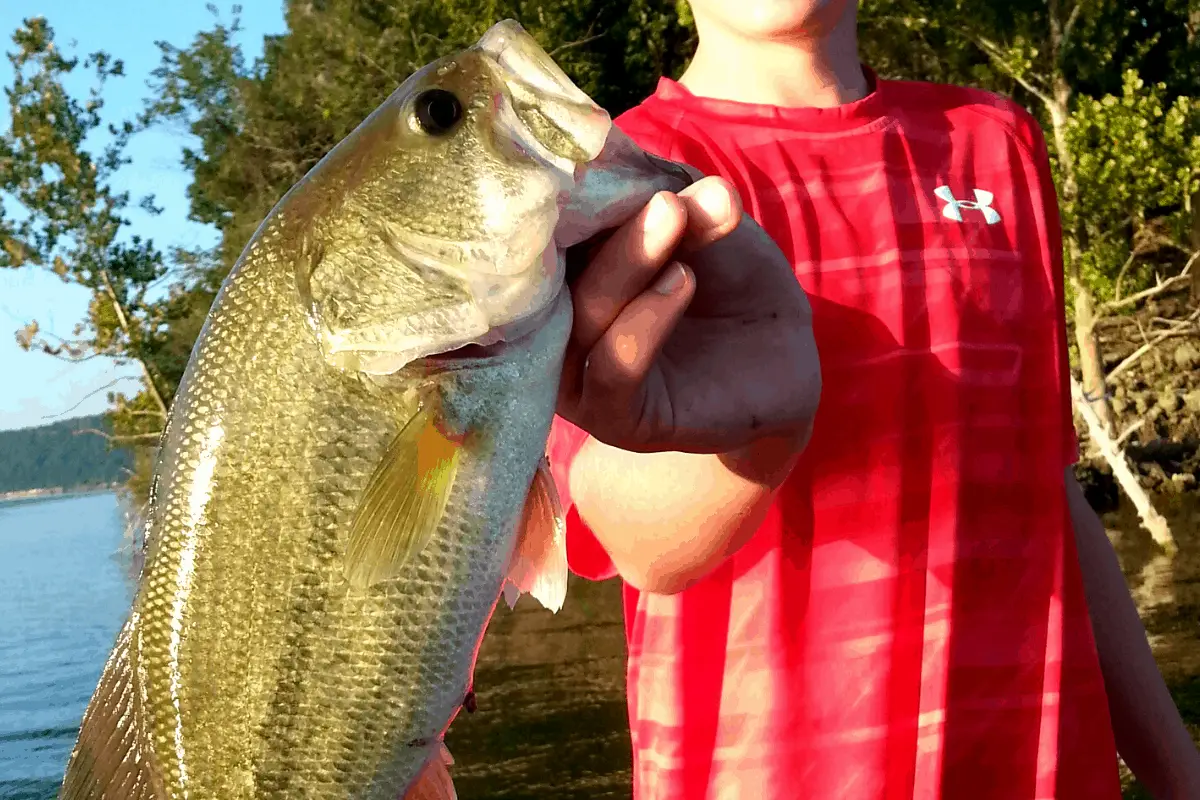Bass fishing is so popular due to the variety of lures and methods that can be used to catch them. Anglers, no matter how experienced, are always learning something new.
- Understand Seasonal Patterns
- Find Cover – Find Bass
- Bass are Ambush Predators – Take Advantage of It
- Match the Forage
- Practice Different Casting Techniques
- Wind Can be a Good Thing
- Wear Proper Eyewear
- Learn Multiple Techniques
- Ask Questions
- Know Your Equipment
In this article, all these topics will be discussed in enough detail to give anglers the opportunity to learn new skills and catch more fish.
1. Understand Seasonal Patterns of Bass
Winter
Much talk has been hitting the Internet about whether water temperature or the amount of daylight plays the determining role in the seasonal pattern of bass.
For the sake of this article, water temperature will be what is focused on, but keep in mind daylight seems to be an important factor. For example, bass can and will be seen in shallow water even when it is quite cold.
During the winter months, the majority of bass will be located in deeper water. If you fish ponds, that may mean ten feet is where they are wintering at. If you fish large impoundments, they may be hanging in fifty feet of water.
Most anglers regard this time of year as the most difficult to fish because of this deep water pattern. A traditional place for bass to move to in the winter is the very center of a channel, cove, pond, or creek arm.
Bass that live in small rivers and streams will often migrate many miles to reach their “wintering holes.”
During the winter, bass will be often grouped in large schools. Once they are located an angler can have a tremendous day on the water. Ice anglers have known this for years and it is not unusual for them to find a school with fifty bass in it.
| Season | Approx. Water Temp |
| Winter | Below 50 |
| Spring | 50-70 |
| Summer | 70+ |
| Fall | 69-50 |
Spring
Once the days become longer and the water temperature is around the 50° mark, bass think about the spawn.
Bass anglers break this breeding season down into three distinct categories: prespawn, spawn, and post-spawn.
The smaller males, or buck bass, will be the first to start scouring the shallows looking for a suitable bedding site. This will most often be on the north side of a lake or pond since that water receives the most direct sunlight. The larger females will hang in staging areas just out of sight waiting for the right time to move up.
These staging areas will often be some sort of structure feature that the bass will hold on. It can even be a piece of cover on structure, like a big boulder on a long tapering point.
When the time is right, the spawn begins. Female bass will join the males and complete the spawning process. Anglers will often see the largest fish of the year during the spawn. This is when a person may catch their personal best since bedding bass get “locked on” and are willing to attack many lures in order to get them away from the nest.
Imitating nest raiding bluegills is a popular method during the actual spawn.
If you catch bedding bass, be sure to snap a photo and quickly release the fish to complete the spawning process. In many states, laws are in place to protect the spawn.
Once the female leaves the nest, the post-spawn period begins.
The males will usually stay on the nest until the eggs hatch. They will then guard them for a few days before leaving the newborn fry to fend for themselves.
The larger females will often move right back to their prespawn staging areas when they first come off the nest.
Summer
Once the spawn is over, most seasoned bass anglers consider it summer fishing.
There will always be fish that can be found shallow, especially in dirty water, but many bass will head back to deeper water when the shallows become too warm.
Summer bass fishing is a popular time to get to the water both early and late to take advantage of low-light periods. Bass often feed overnight and are more susceptible to moving baits since they may be out and away from their normal hiding places.
Topwaters are a favorite during the lowlight periods of summer.
Once the sun reigns high in the sky, a wide range of methods can be utilized to catch summer bass. Shallow water anglers will target the shadiest and thickest cover they can find. Deep water anglers will target bass using methods like the drop-shot rig and use their electronics to pinpoint where schools of summer bass are holding.
Fall
When the days begin to get shorter and the water starts to cool, bass will often move shallow to gorge up and put on fat for the upcoming winter.
Find the food – find the bass.
These wily gamefish will follow huge schools of shad all over the lake. They may be suspending in the middle of nowhere or they may be found in the backs of pockets and coves.
Locate the bait and the bass will be near.
Bass anglers often look to shorebirds and gulls to locate where the bait is. Find these types of birds and you know that you are in a good area.
Fishing in the fall is often a feast-or-famine time for anglers. There is a lot of searching that goes on to find where the fish are using on any given day. When they move shallow to gorge on baitfish, it can also be some of the best fishing of the entire year.
Fall fishing is also a time when many anglers head to the woods for hunting season. It is not unusual to have vast areas of a lake or river all to yourself.

2. Find Cover – Find Bass
Largemouth, smallmouth, and spotted bass can sit in one location and still pull water through their gills for oxygen. They do not need to constantly move which means bass are experts at laying in ambush waiting for prey to come to them.
The thicker the cover, the more likely it is holding bass – and it may be a good one!
There are numerous lures, like soft plastics and jigs, that are made for probing thick cover and to pull out bass that are hiding there.
Typical hiding places may include:
- Rock Piles
- Brush Piles
- Downed Trees
- Thick Vegetation
- Beaver Dams and Huts
- Docks
- Commercial/Industrial Shorelines
When the cover is thick, it is amazing how shallow bass will actually go. They can hold in less than a foot of water if they feel comfortable and safe.
Bass also hold in-and-around cover because it provides shade. These gamefish lack eyelids and the harsh sunlight drives them to find shade no matter the time of year.
Learning to confidently toss a lure into a place where you may get snagged is often the difference between the angler that catches a lot of fish and the angler that misses many opportunities because he or she may only work the outside edges of the cover.
3. Bass are Ambush Predators – Take Advantage of It
Another way to look at it is to think about bass as opportunists. When an easy meal presents itself they often will make the most of it.
Anglers catch bass every year that hit their lure while there is still a partially swallowed bluegill or crawdad jammed in their mouths.
Anytime a person can present a lure in a manner that mimics natural forage and is an easy meal, the odds of catching a bass go way up.
Reaction Bites
Talk to someone who has chased bass for any length of time and they will often mention something called a “reaction bite.”
This type of bite is exactly like it sounds. The bass react.
Predatory fish are not eating 100% of the time. During these periods, anglers need to entice them into biting, and this is often done by making the bass react.
It is similar to someone coming up to you and quickly flashing their hand at your eyes. Your instinct is to move or swat their hand out of the way.
Bass can only react with their mouths.
Skipping jigs under docks and overhanging brush is a great example of provoking a reaction strike. The bass is sitting and hiding when suddenly a jig skips across the surface and lands right in front of them
They often attack it – not out of hunger, but out of instinct.

4. Match the Forage
A good starting place, for all anglers but especially those new to the sport, is to mimic the forage as close as possible.
Fly fishermen use the phrase, “match the hatch.”
Bass eat a wide range of creatures, both aquatic and terrestrial. The closer you can represent the prey, both in coloration and movement, the more likely you are to trigger the feeding instinct.
Let’s use crawfish as an example.
These crustaceans are found in almost every lake, river, and pond in North America. Bass love them.
The color patterns of crawfish vary depending on the food they are eating and the time of year. For example, after the crawfish breed, they molt. It is during this stage that they will be in the brightest color patterns – reds and oranges.
For most of the year, crawfish will be some variation of browns and greens. Selecting lures that closely resemble these color patterns can make a difference in the number of bites a person gets.
It is not unusual to see savvy bass enthusiasts flipping rocks along the shore at the boat launch to see what the crawfish look like. Others may even put out a crawfish trap overnight to match the forage as close as possible.
It pays to do some research on the waters you plan to fish.
Some lakes have threadfin shad while others have no shad at all and bluegill are the main forage.
While on the water pay close attention to what you are seeing. If you are lucky, a bass may even regurgitate a recent meal on your boat deck. This means you can take a look at exactly what they are chomping on at the moment.
5. Practice Different Casting Techniques
This is one of the major differences between advanced anglers and novices.
The ability to put a lure exactly where you want it every time directly translates to more bites.
Some different techniques to learn include: roll casts, flipping, pitching, pitch-skipping, and traditional skipping.
To accomplish this accuracy, it is beneficial to master using baitcast equipment. It takes time, but with proper setup, an angler new to casting gear can be successful with it sooner than they may think.
Practicing in your yard is a great way to hone your skills and apply them to the water. Grab some cement blocks or a small footstool to represent the distance from your boat deck to the surface of the water. Use some targets, like plastic cups, and place them in different locations. Work on each of these different casting techniques.
I also used to set up my cement blocks in the shadows cast by an old cottonwood tree. I imagined the shadows of the branches as a laydown in the water. I would then toss my practice jig into the nooks and crevices.
It doesn’t take long and you can get in a few hundred practice casts.
It pays huge dividends.
Once you have those casting presentations down with your dominant arm, practice with your other arm and hand.
6. Wind Can Be a Good Thing When Bass Fishing
The tendency is on a windy day to find the shelter of a cove or pocket.
Casting can be a pain in the wind, boat control is more difficult, and staying in touch with what is going on at the end of the line is tough.
Still, the wind is a good thing.
Wind generates turbulence in the water column and kick starts the food chain. Microorganisms are dislodged from vegetation and rocks. Small fish and crustaceans feed on these now easily accessible creatures.
The larger predators are not far behind.
Fishing in the wind also hides the movements and actions of anglers. The surface of the water is disturbed making it more difficult for bass to see what is above them.
Keeping our presence hidden ups the odds of catching more and bigger fish.
A strong wind will also position the bass. This type of wind-generated current will cause the predators to move into predictable locations and face into the wind.
Why?
The bass are looking for easy meals to come their way and the wind is pushing it right to them.
Fast-moving, or horizontally presented, baits are great choices when fishing in heavy wind. Spinnerbaits, jerkbaits, and crankbaits all get top billing in these conditions.
Dedicated bass anglers that look for the windiest banks will also benefit from the lack of competition. The majority of other boats will seek shelter where the fishing may not be as good, but casting and boat control is easier.

7. Proper Eyewear
Sight is critical for a bass angler.
The glare caused by the sun keeps the fish hidden and missed opportunities arise.
A pair of polarized glasses will cut the glare and open up an entire world beneath the water. Gray lenses work well on bright sunny days and amber or yellow are preferred on overcast days.
The information an angler can learn from witnessing what is going on is valuable for refining and developing a pattern.
Are there fish shallow? Do you see bass hanging on wood or rock? What type of vegetation is there? Do the fish prefer one type of vegetation over another? Is that dark spot just a rock or is it a bass?
Besides the information garnered from staring into the water, wearing sunglasses is also a must for safety.
Hooks are an always present risk when fishing. Accidents happen and almost everyone ends up getting stuck with a hook at some point, but no one wants to head to the hospital because of an eye injury.
Even on days when it is most tempting to take off the sunglasses, it is best to keep a pair on.
8. Learn Multiple Techniques to Catch More Bass
This is what makes bass fishing so much fun.
Even diehard anglers who have chased their favorite gamefish for a lifetime are always learning. New lures, presentations, and methods are constantly being introduced.
As bass fishing has moved to a worldwide pastime, new methods from highly-pressured lakes make their way to the States and often work well.
The drop-shot rig is a perfect example. The supremely effective finesse technique came from Japan and is now a mainstay here at home.
The ability to adapt is what makes skilled anglers effective. They can adjust lures and presentations to match what the conditions call for. The more techniques a person learns the more he or she can adjust and keep the bite going.
Bass anglers have favorite lures and presentations, but being willing to learn something new is often an eye-opening experience and keeps the sport fun.
Keep learning, absorb as much information as you can, and pass it on to others. Bass fishing is a great sport because we can share our knowledge with anyone.
There still are several excellent magazines, like Bassmaster, where anglers can learn new techniques, but social platforms like YouTube have offered up endless videos on any technique you could think of. The best part is – it’s free.
9. Ask Questions
Experienced bass anglers are often quite receptive to helping out newcomers to the sport.
Don’t be afraid to ask questions when the opportunity exists.
While it may be intimidating at first, being confident enough to go up to someone at a tackle store, hanging out after a presentation at a boat show, or posting a question in a social media group, can offer a wellspring of information.
I learned how to drop shot from a co-angler in a Bassmaster Open tournament on Lake Champlain. I have never forgotten the lessons learned that day and I am still thankful.
There will be those that are reluctant to share and that is OK. Ask the next person and always be grateful for the information.
Young children seem to be open and accepting of asking questions, but as we get older it is harder. We don’t want to appear as if we don’t know something.
Ask a simple question like, “Hey, I am just learning this technique. What’s your best advice?”
Most of the time the person you are asking will love to help. Who knows? You may even find a new fishing partner.
10. Know Your Equipment
It is easy to go broke at the tackle store. The endless lure selection, high-dollar rods and reels, and even tricked out bass boats that push the $100,000 mark, are all enticing and strive to empty our wallets.
With that said, better equipment often yields better results.
Fishing rods are the one area where better equipment directly translates to more bites and bass caught.
The goal of every manufacturer is to produce a rod that is light as possible while maintaining acceptable strength. This higher-quality material costs more.
An angler can use price-point rods when using horizontal presentations, like crankbaits and spinnerbaits. These lures benefit from a more parabolic action, which rods at the lower end of the price spectrum tend to have.
If you like to fish bottom bouncing lures or pitch lures into heavy cover, it pays to save a little more and purchase a rod made from better material. The sensitivity gained will allow better feel and more detected bites.
Every angler has a different budget and what is within reach for some may be out of the question for others.
If you have friends you fish with, ask them to try their equipment for a few casts.
As anglers grow in their skill level, purchasing rods that are designed for specific techniques is also an option.
A drop-shot rod has different characteristics than a rod designed for flipping a jig into a brush pile. A crankbait rod has a different power rating and action than a frog rod.
It seems overwhelming at first, but think of it like a mechanic. There is no one tool that is ideal to fix every problem on a car. Tools are designed to perform specific tasks.
Bass fishing equipment is no different.
Gauge your purchases based on days fished. If you make it out ten days spending a lot of money on a rod may not be worth it. If you spend 100 days a year fishing, then it makes the purchase more reasonable.
Your equipment will grow as you grow as an angler. That is what makes it so fun.
Keep in mind though, the end result is about having a great day and spending time on the water with family and friends.
Final Thoughts
Bass fishing is an amazing sport enjoyed by men, women, children, and folks from every walk of life. There is always something to learn and knowledge to be shared. Thinking about these ten areas will help take your bass fishing to the next level.
- Understand Seasonal Patterns
- Find Cover – Find Bass
- Bass are Ambush Predators – Take Advantage of It
- Match the Forage
- Practice Different Casting Techniques
- Wind Can be a Good Thing
- Wear Proper Eyewear
- Learn Multiple Techniques
- Ask Questions
- Know Your Equipment
Enjoy the process. Have an open-mind, and when possible observe and ask questions of those bass anglers you look up to and respect.
Don’t forget to pass on all your experience to someone else. They will thank you for it.
Tight lines. Be safe, and don’t forget to encourage someone today. You never know how you may change their life forever.
Isaiah 6:8

